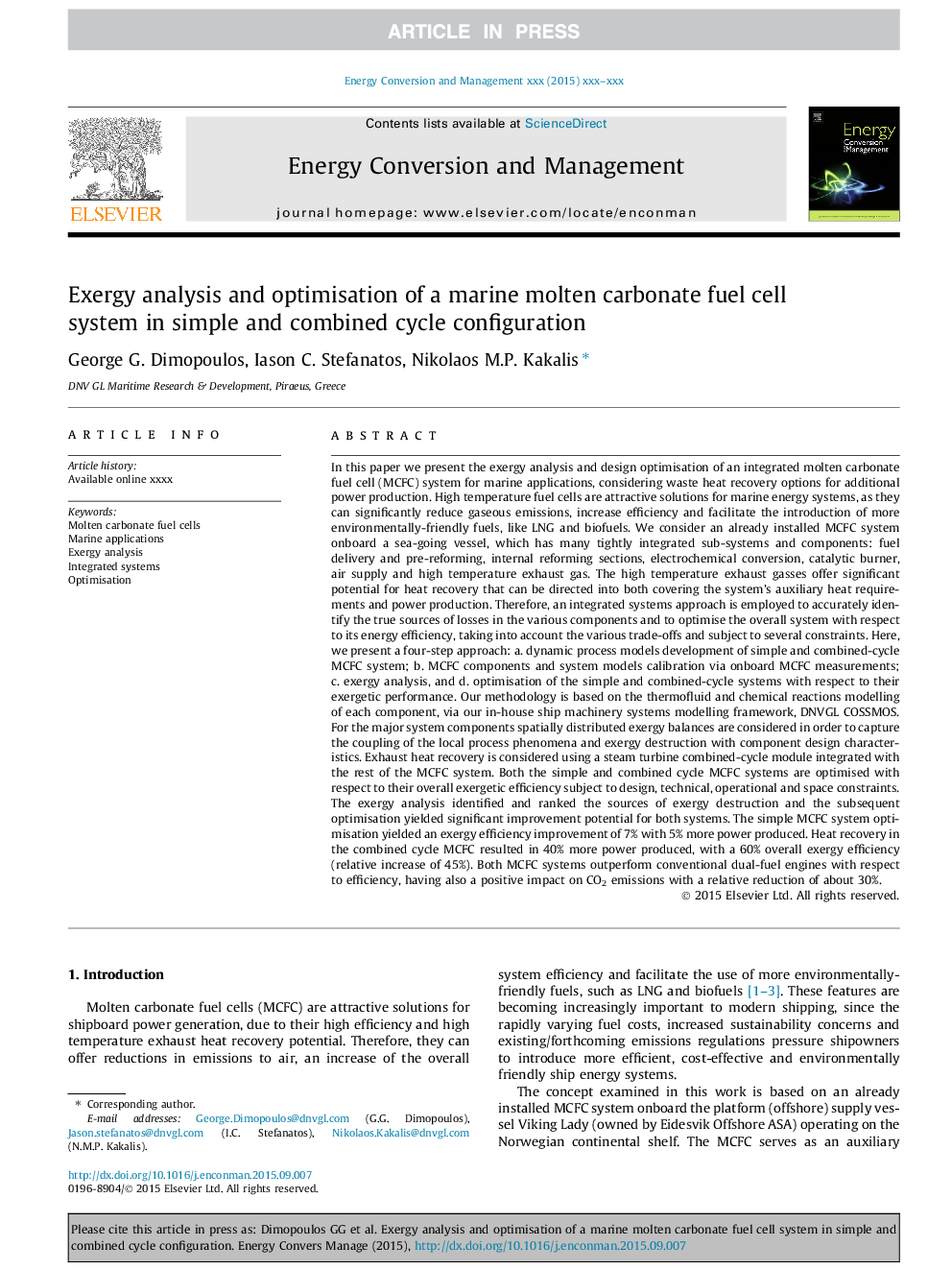| کد مقاله | کد نشریه | سال انتشار | مقاله انگلیسی | نسخه تمام متن |
|---|---|---|---|---|
| 7161531 | 1462855 | 2016 | 12 صفحه PDF | دانلود رایگان |
عنوان انگلیسی مقاله ISI
Exergy analysis and optimisation of a marine molten carbonate fuel cell system in simple and combined cycle configuration
ترجمه فارسی عنوان
تجزیه و تحلیل اگزرژی و بهینه سازی یک سیستم سلول سوختی کربنات مولد دریایی در پیکربندی چرخه ساده و ترکیبی
دانلود مقاله + سفارش ترجمه
دانلود مقاله ISI انگلیسی
رایگان برای ایرانیان
کلمات کلیدی
سلولهای سوخت کربنات خرد شده، برنامه های کاربردی دریایی، تجزیه و تحلیل اگزرژی، سیستم های یکپارچه، بهینه سازی،
موضوعات مرتبط
مهندسی و علوم پایه
مهندسی انرژی
انرژی (عمومی)
چکیده انگلیسی
In this paper we present the exergy analysis and design optimisation of an integrated molten carbonate fuel cell (MCFC) system for marine applications, considering waste heat recovery options for additional power production. High temperature fuel cells are attractive solutions for marine energy systems, as they can significantly reduce gaseous emissions, increase efficiency and facilitate the introduction of more environmentally-friendly fuels, like LNG and biofuels. We consider an already installed MCFC system onboard a sea-going vessel, which has many tightly integrated sub-systems and components: fuel delivery and pre-reforming, internal reforming sections, electrochemical conversion, catalytic burner, air supply and high temperature exhaust gas. The high temperature exhaust gasses offer significant potential for heat recovery that can be directed into both covering the system's auxiliary heat requirements and power production. Therefore, an integrated systems approach is employed to accurately identify the true sources of losses in the various components and to optimise the overall system with respect to its energy efficiency, taking into account the various trade-offs and subject to several constraints. Here, we present a four-step approach: a. dynamic process models development of simple and combined-cycle MCFC system; b. MCFC components and system models calibration via onboard MCFC measurements; c. exergy analysis, and d. optimisation of the simple and combined-cycle systems with respect to their exergetic performance. Our methodology is based on the thermofluid and chemical reactions modelling of each component, via our in-house ship machinery systems modelling framework, DNVGL COSSMOS. For the major system components spatially distributed exergy balances are considered in order to capture the coupling of the local process phenomena and exergy destruction with component design characteristics. Exhaust heat recovery is considered using a steam turbine combined-cycle module integrated with the rest of the MCFC system. Both the simple and combined cycle MCFC systems are optimised with respect to their overall exergetic efficiency subject to design, technical, operational and space constraints. The exergy analysis identified and ranked the sources of exergy destruction and the subsequent optimisation yielded significant improvement potential for both systems. The simple MCFC system optimisation yielded an exergy efficiency improvement of 7% with 5% more power produced. Heat recovery in the combined cycle MCFC resulted in 40% more power produced, with a 60% overall exergy efficiency (relative increase of 45%). Both MCFC systems outperform conventional dual-fuel engines with respect to efficiency, having also a positive impact on CO2 emissions with a relative reduction of about 30%.
ناشر
Database: Elsevier - ScienceDirect (ساینس دایرکت)
Journal: Energy Conversion and Management - Volume 107, 1 January 2016, Pages 10-21
Journal: Energy Conversion and Management - Volume 107, 1 January 2016, Pages 10-21
نویسندگان
George G. Dimopoulos, Iason C. Stefanatos, Nikolaos M.P. Kakalis,
